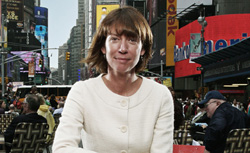Janette Sadik-Khan, New York City Transportation Commissioner
An urban visionary who cuts through the gridlock.
Before Janette Sadik-Khan came along, the job of the New York City transportation commissioner was pretty straightforward: Keep the traffic moving. * In her four-year tenure, Sadik-Khan has transformed the position. She is transportation commissioner as real estate developer, urban beautifier, bicycle advocate, and environmentalist. In the process, Sadik-Khan—"JSK" to those who revere her—has begun to drag the city's transportation infrastructure into the new century.
When Mayor Michael Bloomberg named Sadik-Khan in April 2007, Broadway was still a vehicular thoroughfare, Bronx to the Battery. Now it is a pedestrian mall in the heart of midtown, forcing cars to detour. Whether this makes traffic run more smoothly is a matter of debate. That it has made money for Times Square merchants, however, is widely agreed. In a Slate interview, Sadik-Khan noted that the Department of Transportation is also the city's largest builder (of bridges, roads, ferry terminals, and the like). She has brought a private developer's sensibility to the role, using her power to turn her personal vision into reality. It has worked; for all the initial opposition to the Broadway project, the New YorkTimes called it "perhaps the swiftest re-engineering of a major New York roadway ever."
And that wasn't even her most controversial move. Sadik-Khan has touched off a years-long, pitched battle between drivers and cyclists by installing more than 275 miles of bicycle lanes—with plans for even more. One borough president accused her of trying to turn New York into Amsterdam, and a former transportation commissioner has led a group of Brooklyn residents in filing a lawsuit alleging that the city misrepresented the lanes' benefits. Meanwhile, an op-ed in the Daily News called her bike lane project "an enlightened and overdue rethinking" of street design.
At times, Sadik-Khan has been among those tossing verbal grenades. But her preferred method is to defuse the opposition with cold, hard numbers. Bike lanes, she explains without prompting, have been shown to reduce injuries to cyclists and drivers alike by 40 percent to 50 percent. In New York, she adds, traffic fatalities per capita have declined to record lows. Yes, bike lanes may be the utopian dream of a starry-eyed environmentalist, but they're also "an investment strategy" for the safety of New Yorkers (only one-third of whom, she notes, regularly commute by car). Sadik-Khan also points out 59 percent of city voters support them.
For an official in a city bureaucracy as sprawling and entrenched as New York's, accomplishing anything at all can be a slog. Jay Walder, heralded as a visionary when he took over the New York MTA in 2009, announced last month that he was leaving for a private-sector post in Hong Kong, amid rumblings that he was frustrated with the politics of the job. (Sadik-Khan has been mentioned as a potential candidate to replace him.) How has Sadik-Khan managed to do so much? One tactic that has served her well is to make temporary changes with an eye toward turning them permanent once people get accustomed to them. The mayor's backing hasn't hurt. And her experience in the private sector—she was chief of staff to the CEO of the transportation infrastructure giant Parsons Brinckerhoff—seems to have taught her that coming up with concrete results is more important than trying to please everyone. Even the New Yorkers who oppose her plans grudgingly admit she gets things done.
The bike lane furor still hasn't entirely subsided, but Sadik-Khan is already on to the next big thing—or rather, things: the pedestrian wayfinding project, which will put signs on sidewalks to give pedestrians directions and distances to nearby landmarks; a bike-share plan, modeled on a program that Washington and other cities have implemented to good effect; and Midtown in Motion, which would allow traffic engineers to adjust stoplights remotely as traffic conditions change.
Click here for Sadik-Khan's essay about her vision for New York.
Check out the rest of our government Top Right:
David Bossie, chairman and president, Citizens United
Gen. James Mattis, USMC
Jonathan Gruber, professor of economics, MIT
Michael Crow, president, Arizona State University
.
Clarification, Aug. 9, 2011: In an ill-used figure of speech, this article originally noted that Sadik-Khan's job is to, "Keep the traffic moving and the trains running." Technically, the job of NYC transportation commissioner does not involve any trains. That job falls to the MTA. (Return to the sentence.)


